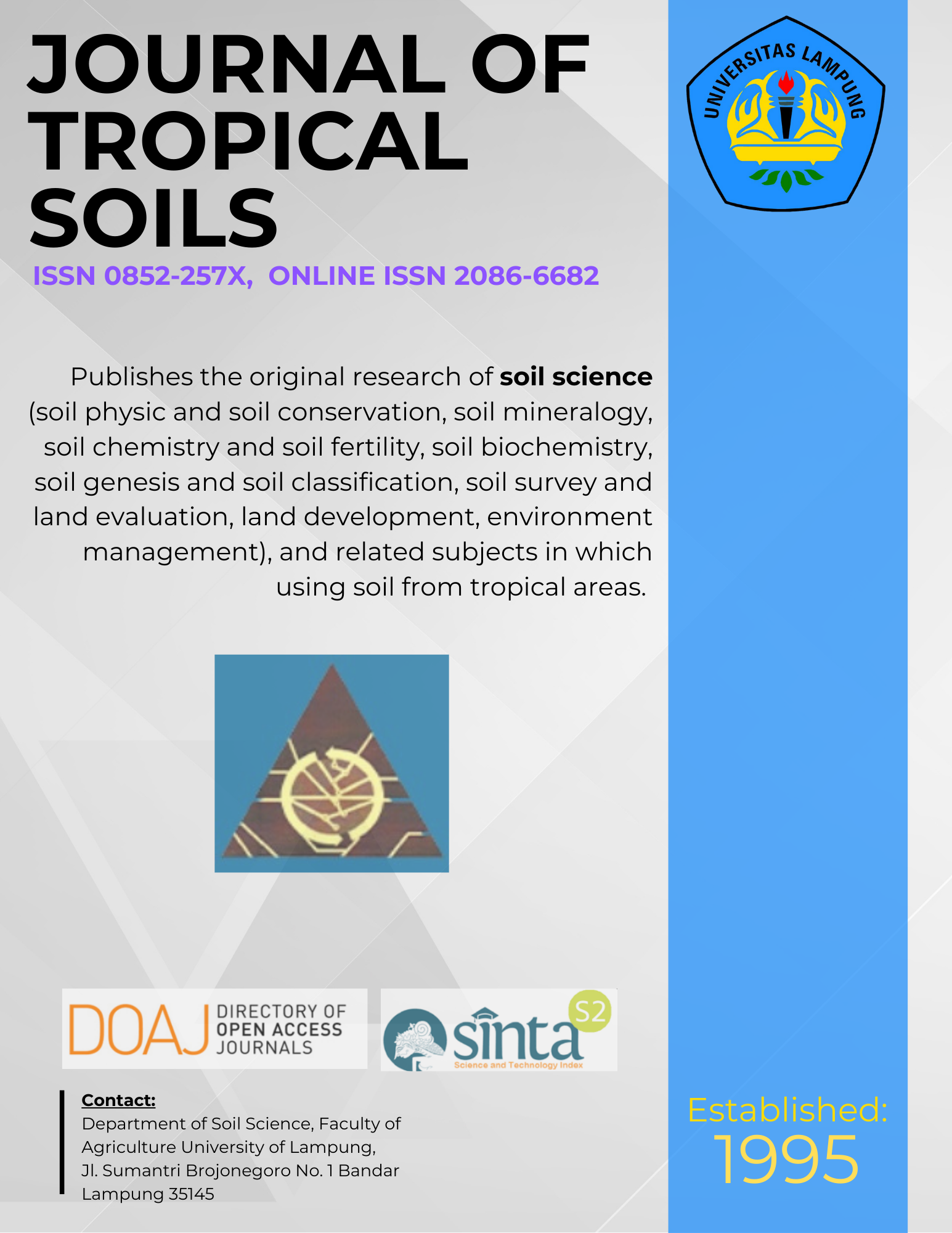Effect Application of Cellulolytic Bacteria Consortium And Palm Kernel Ash on Red Chili Plants in Peat Soil
Main Article Content
Abstract
Downloads
Article Details
Issue
Section
License for Authors
Authors who publish with this journal agree to the following terms:
- Authors retain copyright and grant the journal right of first publication with the work simultaneously licensed under a Creative Commons Attribution License that allows others to share the work with an acknowledgement of the work's authorship and initial publication in this journal.
- Authors are able to enter into separate, additional contractual arrangements for the non-exclusive distribution of the journal's published version of the work (e.g., post it to an institutional repository or publish it in a book), with an acknowledgement of its initial publication in this journal.
- Authors are permitted and encouraged to post their work online (e.g., in institutional repositories or on their website) prior to and during the submission process, as it can lead to productive exchanges, as well as earlier and greater citation of published work (See The Effect of Open Access).
License for Regular Users
Other regular users who want to cite, distribute, remix, tweak, and build upon author’s works, even for commercial purposes, should acknowledge the work’s authorship and initial publication in this journal, licensed under a Creative Commons Attribution License.
How to Cite
References
Aini, D. M. & T. M. Linda. (2020). Potensi konsorsium bakteri selulolitik untuk pengomposan tandan kosong kelapa sawit yang mengandung fitonutrien. Jurnal Natur Indonesia. 18(1): 12-19.
Andriesse, J.P. (2007). Nature and Management of Tropical Peat Soil. Food and Agriculture Organization of The United Nations. Rome.
Badan Pusat Statistik dan Dirjen Hortikultura. (2020). Kementerian Pertanian. Jakarta.
Badan Restorasi Gambut. (2020). Laporan kinerja badan resorasi gambut tahun 2019. Laporan Kinerja Badan Resorasi Gambut. Januari 2020.
Ermawati, T. O Dedi & E. Milda. (2021). Respon pertumbuhan dan hasil cabai merah (Capsicum annum L.) pada pupuk hayati dan NPK majemuk. Jurnal Embrio 13: 1–13.
Gusmawartai & P. R. Sari. (2023). Cellulolytic bacteria decomposers in dry, empty fruit bunches composting. IOP Conf. Series: Earth and Environmental Science, Pp. 1-6.
Hapsoh, ., Gusmawartati, & Yusuf, M. (2016). Effect Various Combination of Organic Waste on Compost Quality. Journal of Tropical Soils, 20(1), 59–65. https://doi.org/10.5400/jts.2015.v20i1.59-65
Hardjowigeno, S. (1995). Ilmu Tanah Cetakan 7. Akademi Pressindo. Jakarta.
Kementerian Lingkungan Hidup dan Kehutanan (KLHK). (2020). Rekapitulasi luas kebakaran hutan dan lahan per provinsi di Indonesia tahun 2015–2019. Jakarta.
Masganti. (2013). Teknologi inovatif pengelolaan lahan suboptimal gambut dan sulfat masam untuk peningkatan produksi tanaman pangan. Pengembangan Inovasi Pertanian 6:187-197.
Mulyani, S., Suryaningtyas, D. T., Suwardi, ., & Suwarno, . (2017). Quality Improvement of Compost from Empty Oil Palm Fruit Bunch by the Addition of Boiler Ash and its effect on Chemical Properties of Ultisols and the Production of Mustard (Brassica juncea L.). Journal of Tropical Soils, 21(3), 161–169. https://doi.org/10.5400/jts.2016.v21i3.161-169
Nopiandi, Y & M. D. Anwar. (2017). Pengaruh dosis petroganik dan pupuk hayati petrobio terhadap pertumbuhan dan produksi tanaman cabai merah (Capsicum annuum L.) varietas gada F1. Jurnal Hijau Cendekia 2: 27–34.
Notohadiprawiro, T. (1999). Tanah dan lingkungan. Direktorat Jendral Pendidikan Tinggi Departemen Pendidikan dan Kebudayaan. Jakarta. 237 hal.
Satria Nur, H., Meryandini, A., Hamim, dan, Nur, S., & Meryandini, A. (2009). Pemanfaatan Bakteri Selulolitik dan Xilanolitik yang Potensial untuk Dekomposisi Jerami Padi (H. J. Tanah Trop, 14(1), 71–80.
Peraturan Menteri Pertanian No 01. 2019. Pupuk organik, pupuk hayati, dan pembenah tanah. Kementerian Pertanian.
Ramanda, R. F., B. Setiawan & A. Wijaya. (2022). Pengaruh pemberian abu janjang kelapa sawit terhadap pertumbuhan bibit kelapa sawit (Elaeis guineensis Jacq) pada media gambut. Journal of Agro Plantation 1: 93-102.
Sutedjo M.M., A.G. Kartasapoetra, & R.D.S. Sastroatmodjo.1991. Mikrobiologi Tanah. Rineka Cipta. Jakarta. 447 hal.
Wahyuni, D., S. Khotimah dan R. Linda. (2015). Eksplorasi bakteri selulolitik pada tingkat kematangan gambut yang berbeda di kawasan hutan lindung gunung ambawang kabupaten Kubu Raya. Jurnal Protobiont 4: 69–76.
Winarso, S. (2005). Kesuburan tanah: dasar kesehatan dan kualitas tanah. Gava Media. Yogyakarta. 269 hal.

